We have ads and affiliate links sprinkled around like dog treats at a training session. As an Amazon Associate we earn from qualifying purchases. If you click and make a purchase, we earn a few kibbles to keep this dog park of a website running. So, thanks for tossing us a bone.
Large dog breeds for apartments can be a fantastic choice, proving that living in an apartment doesn’t limit you to only small pets.
Many large dogs adapt impressively well to apartment living, provided their physical and mental needs are adequately met.
Understanding the unique challenges and advantages of keeping a large dog in a smaller space is crucial to ensuring a happy and healthy life for your canine companion.
When considering large dog breeds for apartments, it’s important to evaluate the breed’s energy levels, exercise requirements, and temperament. Large dogs can thrive in apartment settings if they are given proper exercise, training, and attention.
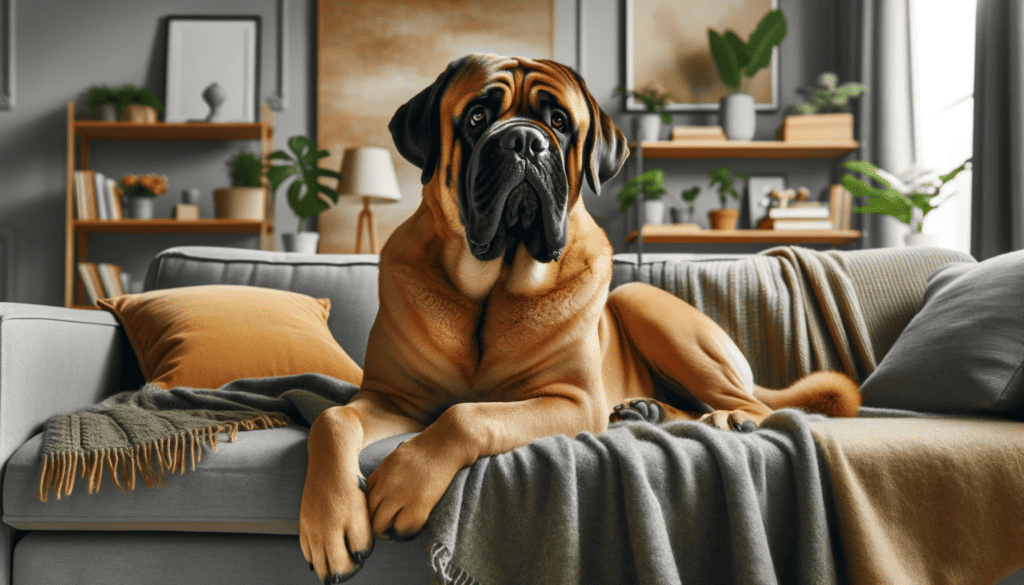
Regular walks and trips to the dog park are essential for maintaining their physical well-being, while obedience training aids in their mental stimulation and social behavior.
Similarly, day-to-day life with a large dog in an apartment necessitates a routine that includes ample playtime, space management, and consistent care routines to keep your pet healthy.
Key Takeaways of Large Dog Breeds for Apartments
- Large dog breeds can be suitable for apartment living with proper care and exercise.
- Regular training and socialization are essential for the well-being of large dogs in apartments.
- Daily routines that address physical and mental needs are crucial for large dogs living in smaller spaces.
Assessing Apartment Suitability for Large Dogs
When considering large dog breeds for apartments, it’s essential to evaluate the living space, how sound travels, available amenities, and the dog’s temperament to ensure a good fit for both you and your pet.
Space Considerations for Large Dog Breeds for Apartments
When considering a large-breed dog for your apartment, it’s crucial to ensure ample space for their comfort and movement.
Big dogs can do well in apartments if they have enough room for essential activities, such as:
- A specific area for their bed, preferably in a quieter part of your home
- Unobstructed pathways in your living space to prevent accidents or injuries
- Sufficient space: Ideally, a large living room or similar area, plus additional space for a big dog bed
- Room to play and stretch inside, ensuring they’re not cramped or restricted
Noise Factors
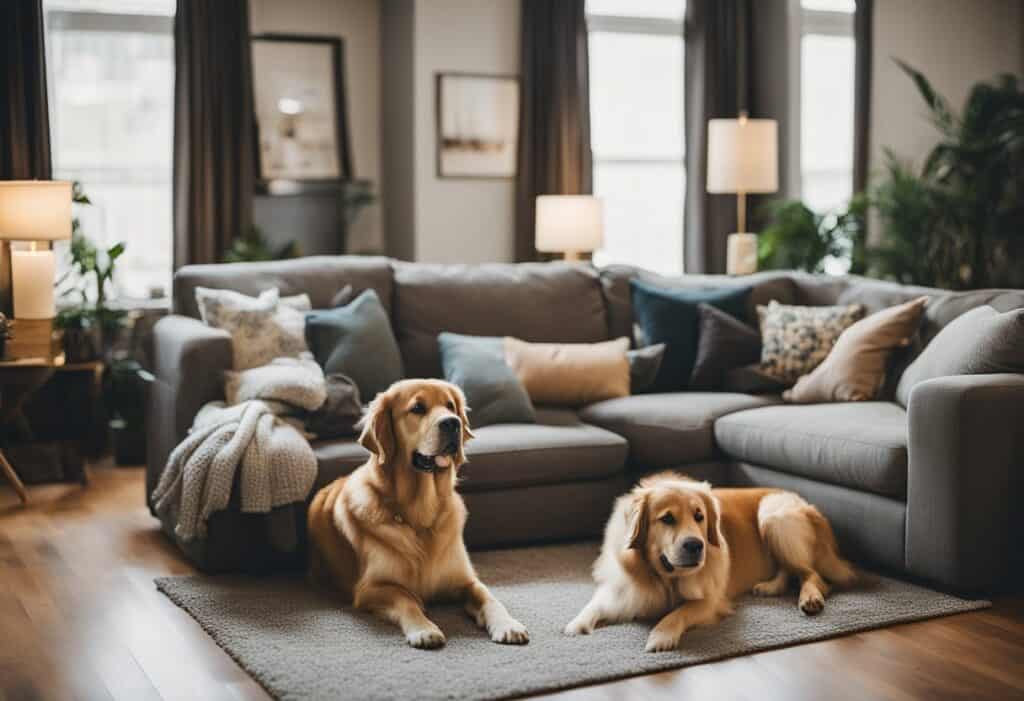
When considering a large dog breed for your apartment, it’s important to think about the dynamics of apartment living.
This includes your dog’s comfort in a smaller space and ensuring that your neighbors aren’t disturbed. Some large breeds are naturally more suitable for such environments due to their quieter nature.
Barking Habits
Before choosing a large dog for your apartment, consider their barking habits. This is crucial for maintaining a peaceful environment for both you and your neighbors.
- Select breeds known for being less vocal to avoid frequent noise.
- Look for dogs with a naturally calm temperament who are less likely to react with barking.
- Choose breeds with a low propensity for excessive barking.
- Consider breeds that tend to be more laid-back and less reactive to stimuli.
Soundproofing your apartment can significantly help in managing noise levels. This is beneficial not just for your neighbors, but for the overall well-being of your dog, especially in a high-density living situation.
Apartment Soundproofing
- Ensure your apartment has effective soundproofing to minimize disturbance.
- Utilize rugs, curtains, and soft furnishings to absorb sound.
- Consider soundproofing specific areas where your dog spends a lot of time.
- Make sure doors and windows are properly sealed to prevent noise leakage.
Managing the noise a dog makes in an apartment requires some proactive steps. These can range from choosing the right breed to providing appropriate training and environmental enrichment.
Noise Management Tips for Large Dog Breeds for Apartments:
- Opt for breeds with a natural inclination to be quieter.
- Provide ample mental and physical stimulation to prevent boredom-related barking.
- Regularly train your dog to control barking behaviors.
- Establish a daily routine that includes quiet and relaxation time to help reduce anxiety and noise.
When searching for the perfect apartment to share with a large dog, it’s essential to consider the amenities provided.
These can make a significant difference in the ease and quality of life for both you and your pet. Here are some key amenities to look out for:
Apartment Amenities:
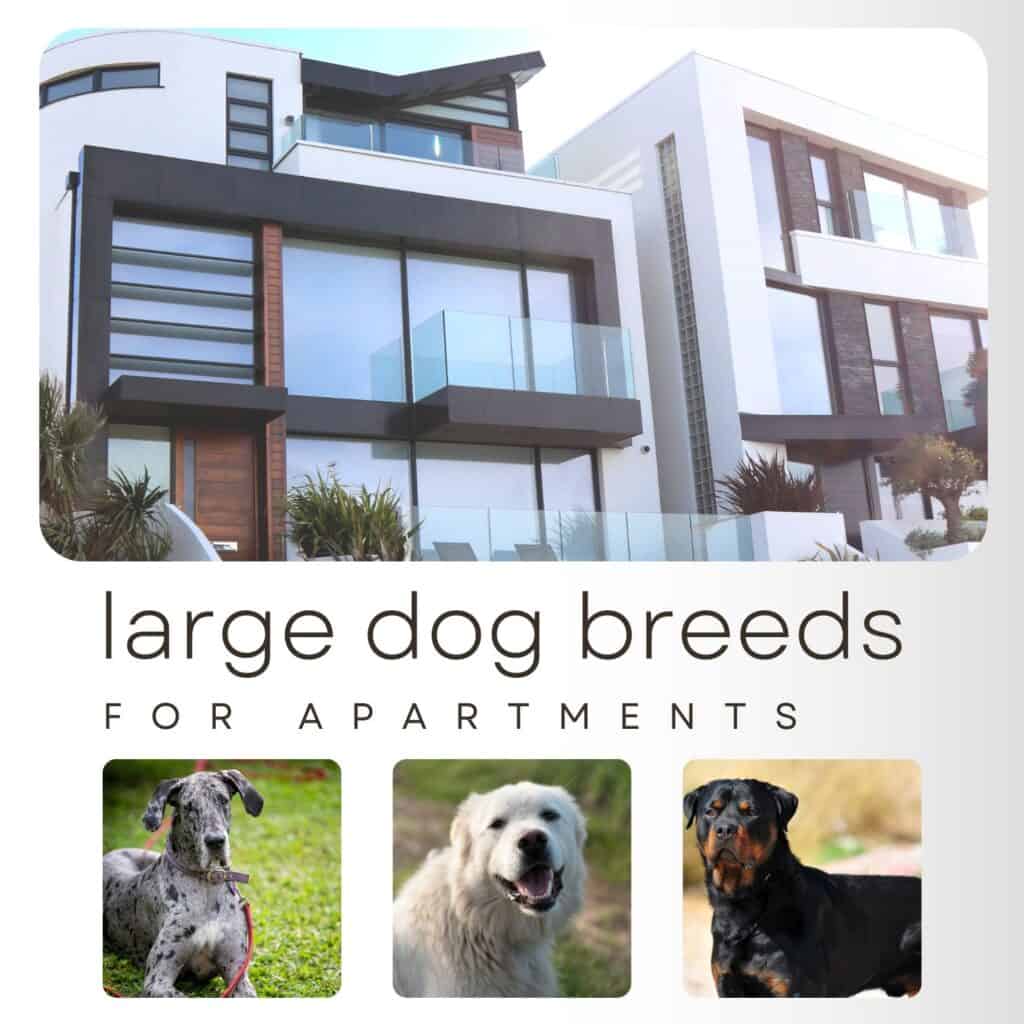
- An elevator, particularly crucial if you’re living on a higher floor, to make it easier for your dog to move in and out.
- Proximity to green spaces or parks, offering convenient options for walks and exercise.
- A pet relief area within the apartment complex for quick and easy bathroom breaks.
- Availability of pet-friendly services such as designated dog-walking or pet-sitting.
- On-site or nearby veterinary services for quick access to healthcare.
- Spacious layouts to ensure enough room for your dog to move and play comfortably.
- Pet grooming facilities on the premises or nearby.
- Dog-friendly community areas where your pet can socialize safely.
Breed Temperament and Energy Levels for Large Dog Breeds for Apartments
Large dog breeds come with a range of temperaments and energy levels. It’s important to match these traits with your lifestyle and apartment space. While some breeds are high-energy and need lots of exercise, others are more relaxed and happy with indoor activities. Here are some key considerations:
Exercise Needs:
- High-energy breeds need consistent, vigorous exercise to stay content.
- Moderate-energy dogs require regular walks and active playtime.
- Lower-energy breeds often thrive with shorter walks and less intense activities.
Indoor Play:
- Opt for breeds that engage well with indoor games for mental engagement.
- Some dogs enjoy interactive toys that stimulate their minds.
- Breeds that are content with indoor play are ideal for less active owners or smaller spaces.
Breed Examples and Their Needs:
| Breed | Energy Level | Exercise Requirements |
|---|---|---|
| Great Dane | Low to Moderate | Short walks, gentle play |
| Mastiff | Low | Brief playtime, casual walks |
| Greyhound | Moderate | Regular runs, active play |
| Labrador Retriever | High | Vigorous exercise, long walks |
| Boxer | High | Intense play sessions, runs |
| Bernese Mountain Dog | Moderate | Daily walks, playtime |
| Saint Bernard | Low to Moderate | Casual strolls, indoor activities |
| Golden Retriever | High | Long walks, interactive play |
| Newfoundland | Moderate | Regular exercise, swimming |
| Rottweiler | Moderate to High | Structured exercise, training games |
This table helps in understanding what to expect from various large breeds in terms of their energy needs and suitable exercise routines.
Choose a breed that matches your lifestyle and your apartment’s space and amenities, ensuring a harmonious living environment.
Selecting the Right Large Dog Breed for Apartment Living
Finding a suitable large dog breed for your apartment involves considering factors such as exercise needs, barking tendencies, temperament, allergies, and space requirements.
Breeds With Low Exercise Needs:
- Greyhounds: Known for their speed, Greyhounds are surprisingly laid-back at home. They enjoy lounging around and require only brief, intense exercise sessions, making them suitable for apartment life.
- Basset Hounds: These dogs are famous for their relaxed demeanor. Basset Hounds love long naps and don’t need much exercise, which makes them ideal for a low-activity lifestyle in an apartment.
Breeds That Are Less Prone to Barking:
- Mastiffs: Mastiffs are large yet notably quiet. They’re less likely to bark excessively, making them a good choice for keeping the peace in apartment settings.
- Bulldogs: Known for their calm nature, Bulldogs typically don’t bark much. Their quiet demeanor is a plus for apartment dwellers concerned about noise.
Breeds With Amiable Temperaments:
- Bernese Mountain Dogs: These dogs are renowned for their friendly and gentle nature. Bernese Mountain Dogs are great for apartments due to their pleasant disposition towards neighbors and other residents.
- Newfoundlands: With their sweet and loving temperament, Newfoundlands are wonderful companions. They are known for being good-natured and friendly, making them ideal for community living.
Hypoallergenic Breed Options:
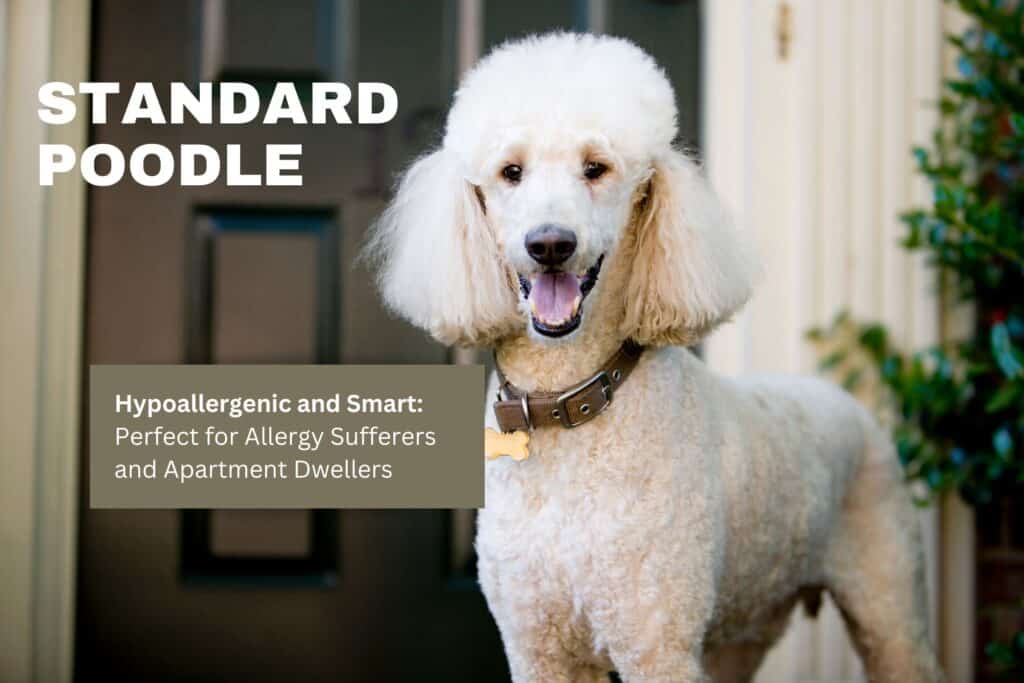
- Poodles (Standard Poodle): Ideal for allergy sufferers, Poodles have a hypoallergenic coat. Their intelligence and trainable nature also make them excellent choices for apartment living.
Small-Space-Friendly Giant Breeds:
- English Mastiff: Despite their size, English Mastiffs can adapt well to apartment living with their laid-back nature, as long as they get regular walks.
- Irish Wolfhound: Known for their gentle personality, Irish Wolfhounds can live comfortably in apartments if given enough exercise.
- Saint Bernard: These gentle giants can adjust to smaller spaces, provided they receive adequate daily exercise.
- Leonberger: Leonbergers, with their calm and friendly demeanor, can be suitable for apartment living with proper exercise and mental stimulation.
Health Considerations and Care Routines for Large Dog Breeds for Apartments

Caring for large dog breeds in apartments requires awareness of their specific health issues and knowledge about daily care routines to sustain their well-being.
Common Health Issues in Large Breeds
Large dog breeds often face particular health challenges that can affect their quality of life. For example:
- Hip Issues: Breeds like the Mastiff and Bernese Mountain Dog are prone to hip dysplasia.
- Skin Conditions: Wrinkled breeds such as the English Bulldog and Chinese Shar-Pei can suffer from skin infections in their folds.
- Heart Diseases: The Afghan Hound and Greyhound are susceptible to hereditary heart conditions.
Prevention and early detection are key, so regular vet check-ups are essential.
Health Benefits of Suitable Living Conditions
Suitable living conditions can greatly enhance a large dog’s health, especially in apartment settings:
- Exercise: Daily walks are crucial for physical health.
- Mental Stimulation: Providing mental stimulation prevents behavioral issues.
- Regular Routines: A balance of activity and rest promotes overall health.
Creating a pet-friendly space that accommodates a large dog’s needs is vital for their physical and mental well-being.
Grooming Needs
Proper grooming is essential for a large dog’s overall health, and the requirements can differ significantly based on the breed:
- Afghan Hound: These long-haired beauties need regular, often daily, brushing to keep their luxurious coats tangle-free and healthy.
- Poodles: While not a giant breed, Standard Poodles, being large-sized, require professional grooming to maintain the health and appearance of their unique coats.
- Labrador Retrievers: These short-haired breeds still need routine grooming. Regular brushing helps keep their skin healthy and coat shiny.
- Golden Retrievers: With their thick, water-repellent double coats, they need regular grooming to prevent matting and maintain coat health.
- German Shepherds: Known for their dense fur, they require frequent brushing to manage shedding and maintain coat health.
- Saint Bernards: These gentle giants have dense, long coats that need regular grooming to stay clean and prevent matting.
- Newfoundlands: Their thick, heavy coats require consistent grooming to keep them looking their best and to avoid tangles.
- Bernese Mountain Dogs: Their long, silky fur needs regular brushing and occasional trimming to stay healthy and manageable.
Incorporate grooming into your pet’s routine to manage shedding and prevent matting.
Diet and Nutrition with Large Dog Breeds for Apartments
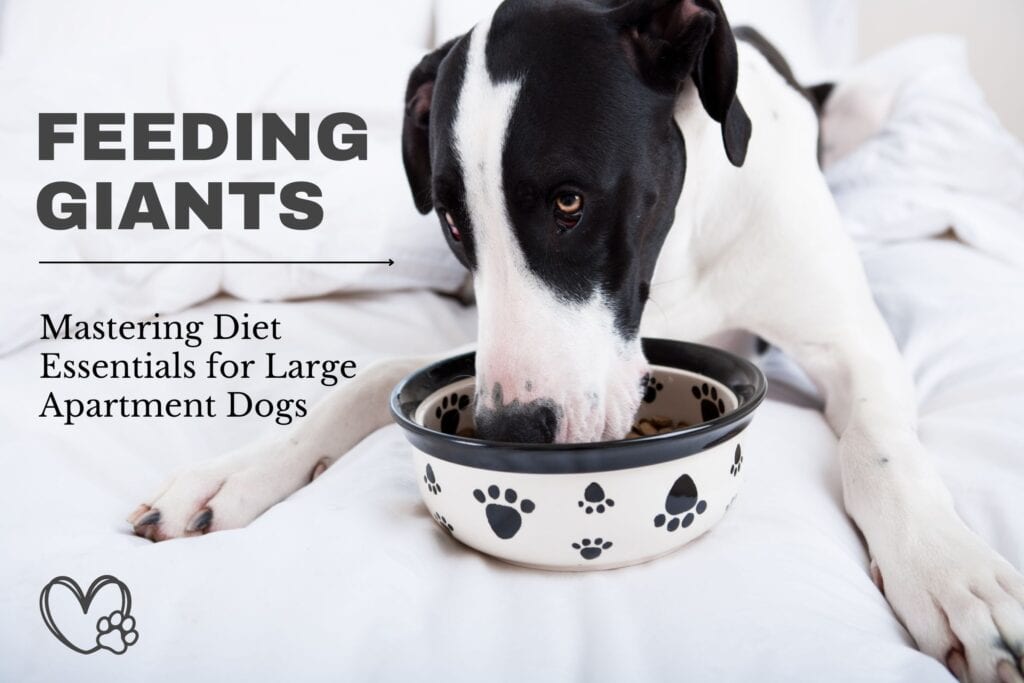
Ensuring the right diet for large dog breeds is crucial, especially considering their unique nutritional needs related to their size and lifestyle:
- High-Quality, Age-Specific Food: Choose a diet that supports their bone and joint health, crucial for larger breeds.
- Controlled Portions: Proper portion control is essential to prevent obesity, especially in less active dogs living in apartments.
- Balanced Ingredients: Look for foods with a balance of protein, fats, and carbohydrates suitable for their breed and energy level.
- Supplements for Joint Health: Consider adding supplements like glucosamine and chondroitin to support joint health.
- Regular Meal Times: Establish consistent feeding schedules to aid in digestion and weight management.
- Low-Calorie Treats: Opt for healthier, low-calorie treats to avoid weight gain, especially if your dog is less active.
- Hydration: Ensure they have constant access to fresh water, as large breeds may need more hydration.
- Special Diets for Health Issues: Be aware of any breed-specific health issues that may require a specialized diet.
- Avoid Human Food: Steer clear of feeding them human food, which can lead to unhealthy weight gain and other health issues.
- Veterinarian Consultation: Regularly consult with a vet to adjust their diet as they age or if their lifestyle changes.
Large Dog Breeds for Apartments
Training and Socializing Large Dogs in Apartments
Proper training and socialization are crucial to harmoniously living with a large dog in an apartment setting. Adequate exercise, effective obedience training, and neighborly socialization tactics are core to a well-adapted pet.
Obedience and House Training
For obedience training, establish a routine that includes:
- Daily walks: These are essential not just for exercise but also for potty training.
- Commands: Sit, stay, come, down, and leave it are basics that promote good behavior.
- Consistency: Repeat commands and maintain a consistent schedule to reinforce training.
House training involves:
- Crate training: Offers a safe space for your dog and aids in managing separation anxiety.
- Regular breaks: Take your any large breed dog out frequently, especially after eating or drinking.
Proper exercise helps to manage common issues like barking, which might disturb neighbors.
Socialization Strategies
Socializing your large dog, especially when living in an apartment, involves several key steps to ensure they are well-behaved and comfortable in close-knit community settings:
- Meeting Neighbors: Actively introduce your dog to neighbors to build familiarity and reduce fear or aggression.
- Quiet Commands: Train your dog to respond to quiet commands, helping to manage noise levels in the apartment.
- Polite Behavior: Consistently reward your dog for displaying calm behavior in shared areas like hallways and elevators.
- Leash Training: Ensure your dog is well-trained on a leash for safe and controlled walks in communal areas.
- Socialization Classes: Consider enrolling your dog in socialization classes to improve their comfort around people and other pets.
- Positive Reinforcement: Use positive reinforcement techniques to encourage friendly interactions with others.
- Desensitization to Noises: Gradually expose your dog to various sounds and stimuli common in apartment living to reduce anxiety or overreaction.
- Regular Playdates: Arrange playdates with other dogs to enhance social skills and provide exercise.
- Controlled Greetings: Teach your dog to greet people and other animals in a controlled manner, preventing jumping or overly enthusiastic behavior.
- Familiarization with Elevators and Stairs: Get your dog accustomed to riding in elevators and navigating stairs, if applicable, to reduce stress during daily routines.
Day-to-Day Life with a Large Dog in an Apartment
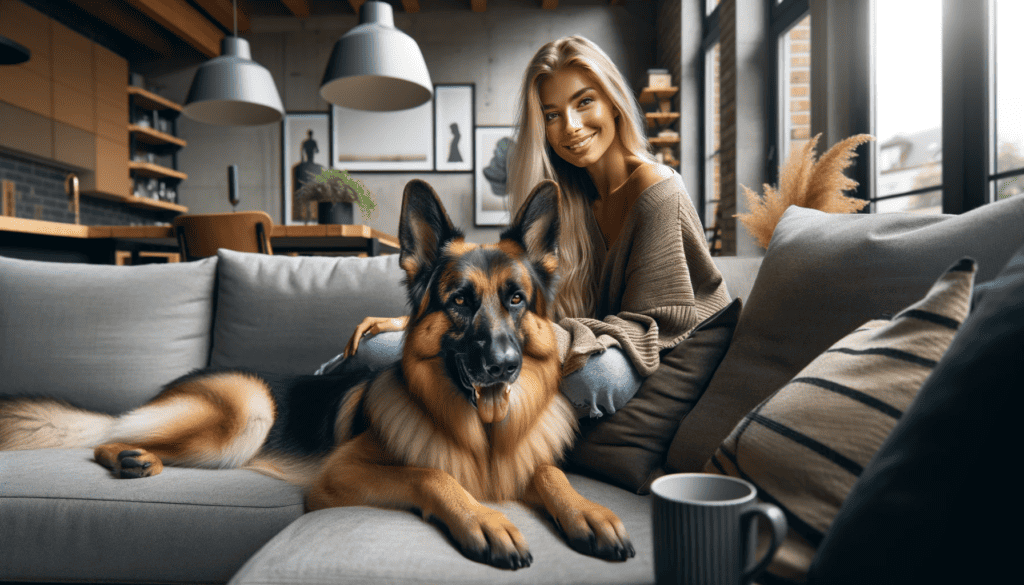
Owning a large dog breed in an apartment requires careful planning to ensure their well-being, as well as maintaining a harmonious environment for both the pet and the owner.
Exercise, comfort, and behavioral management are crucial components.
Exercise and Play
Exercise: Regular exercise is key to keeping your large dog healthy. Breeds like Labradors or Golden Retrievers, for example, will benefit greatly from at least 30 minutes of brisk walking twice a day.
Play: Engaging in playtime is important for your dog’s mental stimulation and strengthening your bond. Use interactive toys for indoor fun, and turn your hallway into a play area for games like fetch, which breeds like German Shepherds or Boxers would enjoy.
Creating a Comfortable Living Environment
Living Space: Allocate a specific area in your apartment for your dog, such as a large cushion or a part of the sofa, making it a comfortable spot for large breeds like Great Danes or Saint Bernards.
Furniture: Choose sturdy, dog-friendly furniture. Large breeds like Mastiffs or Newfoundlands need durable and comfortable places to relax, such as a designated part of your sofa.
Managing Separation Anxiety
Routine: Establish a consistent daily routine for activities like feeding and walking. This is particularly beneficial for breeds like German Shepherds or Bernese Mountain Dogs, which can be prone to separation anxiety.
Neighbors: Let your neighbors know about your large dog to create understanding and mitigate concerns. Training your dog to minimize barking will help prevent disturbances, which is especially important for breeds known for their protective nature, like Rottweilers or Dobermans.
Frequently Asked Questions about Large Dog Breeds for Apartments
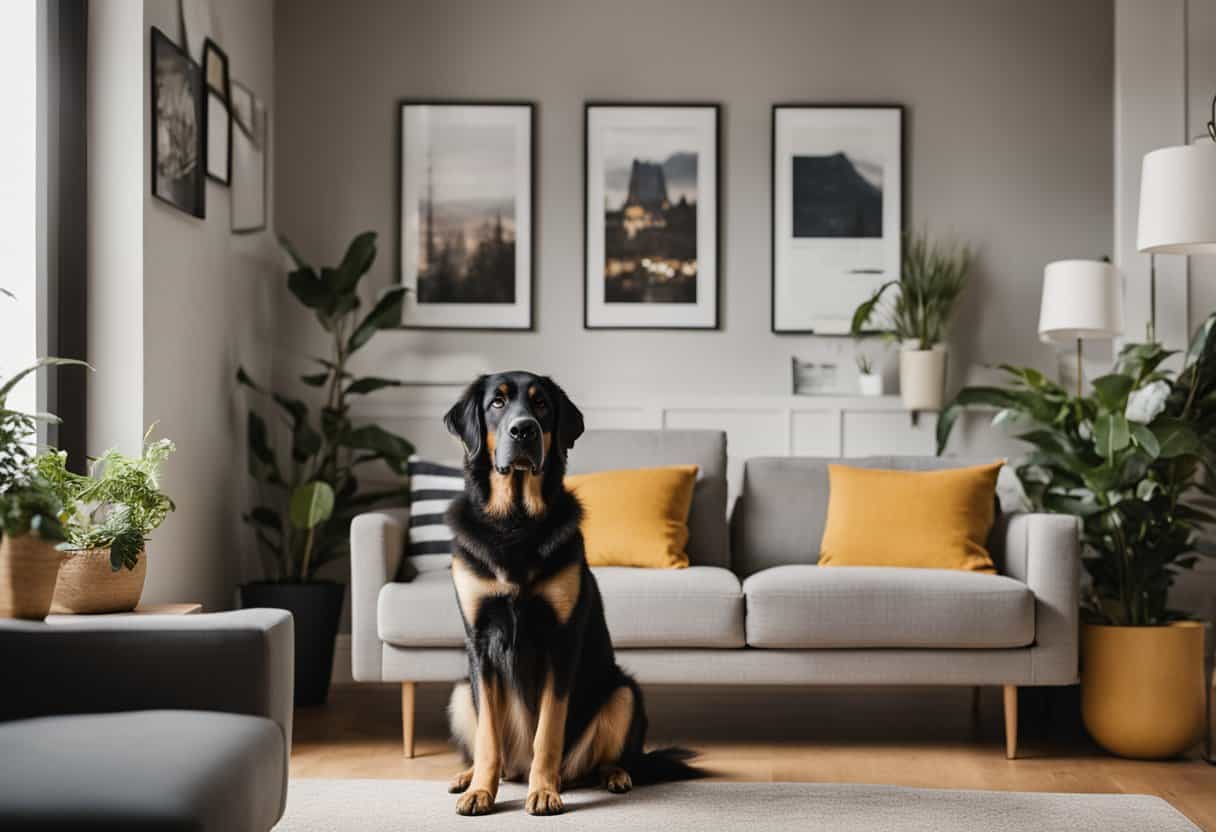
When you’re considering large dog breeds for apartment living, understanding their needs and energy levels is key.
Which large dog breeds are well-suited for apartment living?
Greyhounds, Great Danes, and Mastiffs are known for their calm dispositions and can adapt well to apartment living despite their size.
What factors make a large dog breed suitable for living in an apartment?
A suitable large breed for an apartment typically exhibits lower energy levels, a calm temperament, and can adapt to a less active lifestyle.
How can you ensure a large dog is comfortable in a smaller living space?
Provide regular exercise, create a dedicated space for your dog, and ensure mental stimulation through toys and interaction to keep your large dog content in a smaller space.
Which low-energy large dog breeds are recommended for apartment dwellers?
The Basset Hound and Bulldog are large breeds with relatively low energy, making them suitable for apartment life.
Can working individuals find large dog breeds that can adapt to apartment life?
Working individuals should look for large dog breeds that are independent and can remain calm when left alone, such as the Shar-Pei or the Newfoundland.
What are the best practices for keeping a large dog in an apartment?
Ensure consistent exercise, maintain a routine, and provide proper training to help your large dog thrive in an apartment setting.
Big Love in Small Spaces: Wrapping Up Large Dog Breeds for Apartments
Having a large dog in an apartment isn’t just possible; it can be a joyful and fulfilling experience. By choosing the right breed, understanding their needs, and creating a comfortable living environment, you can ensure both you and your gentle giant thrive in your cozy urban space.
Remember, it’s not about the size of your home, but the love and care you provide that makes it a perfect abode for your large furry friend.
